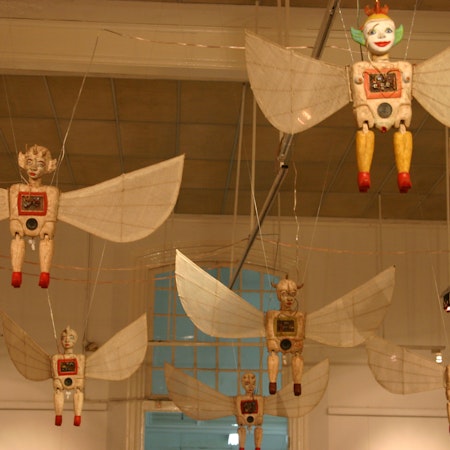Heri Dono has been called a contemporary shaman, a low-tech wizard, one of the stars in the intergalactic universe of international biennales. The last claim he modestly denies, yet the works of the Yogyakarta-based artist reflect all of the monikers above: mystical, idiosyncratic, deeply personal and at the same time highly charged in their political context.
His home country Indonesia and his ethnic roots in Javanese culture provide the ever-present sociopolitical background of Heri's works. It is interesting to note that while he is constantly on the move to many cities around the world, the transient nature of his travels seems to strengthen Heri's personal and critical perception of his ethnic and national background. He incorporates various forms of traditional Indonesian visual culture as a way of conveying the fear and instability that underlies Indonesia's sociopolitical past and present. His artistic language is a conglomeration of painting, sculpture, electronic installation, and, quite significantly, the wayang (shadow puppet) performance. By virtue of the fact that these activities often involve the participation of the public, Heri likes to create an alternative public arena for critical dialogue through his works.
Heri's current installation at Gertrude Contemporary Art Spaces, The Broken Angels, narrates the story of Indonesia's reformation process. Referring back to the Reformasi (Reformation) movement, which in May 1998 brought to an end the thirty-two-year-old New Order regime of former president Soeharto, The Broken Angels tells of the aftermath of the historic events. Reformasi failed because it was internally divided and politically immature. In fact, many of its proponents simply did not know what to do when the much-hated dictator stepped down. Ultimately, the fall of Soeharto only brought about a change at the very top of the power pyramid, while many structural features of the regime remained unchanged.
Heri's angels are suspended amid a background of paintings that depict another momentous event in Indonesian history, the Supersemar (the Letter of Eleven March, the disguised coup by Soeharto in 1966 which marked the beginning of the New Order era).
Representing the failed dreams of a reformed nation with a background of grotesque figures and rollicking scenes, the angels are depicted partially complete and suspended in a status quo. Heri's quasi-human dolls are reminiscent of eighteenth century automata and robots. The role of an automaton is to question the status and actions of human beings and, in connection with Heri's angels, the consequences of human actions. The dolls also mirror the figures in his painting: the wayang.
Having learned the process of puppet-making from an old master, Heri's angels still resemble traditional figures; flat, two-dimensional, highly stylised and of mythical standing. Traditionally, the wayang figures are seen as a mixture of representation of the Hindu gods and the ancestors of the Javanese. The shadow-puppet performance itself is a combination of gamelan (traditional music instruments), singing, chanting. storytelling and a landscape of images laden with metaphors and allegories, which remain contemporary as a means to launch criticisms understandable to common people.
The Supersemar narration in the background of Heri's installation not only gives a visual and social backdrop of what the angels narrate, but also alludes to the most favoured demi-god in Javanese folklore; a fallible deity called Semar, who is wise yet prone to uncontrollable bouts of farting. The figures in Heri's paintings are humans who assume the role of the wayang characters, narrating the rise and fall of power and the grey ethics of the characters. Traditionally, wayang performances are never moralising, rather they portray the moral pluralism of the characters; they may be good, yet their weaknesses are also ever-present.
Despite his reference to the traditions and culture of Indonesia, specifically those from Java, Heri refuses to remain in the framework of given traditions, whether historical or contemporary. While contemporary artists often explore multi-media with computer Technology, multi-media in Asian art means something different for him: tin toys powered by steam or alarm clock mechanisms (made in China) are also a kind of multi-media for Heri.
John Clark, in his text Modern Asian Art, argues that the problem of stylistic discontinuity - from tradition to modernity - in many works in Asian countries arises from the state power and 'historical amnesia' in local art discourse. This discontinuity often resulted in avant garde movements which adopted contesting positions, cross-cultural references and neo-traditional discourses'. In Heri's works the messages are universal in exploring oppression and the human condition, between tradition and modernity, through humour and irony.
The title of this essay is actually a remark from one of Heri's friends, who is amazed by Heri's endurance in traveling the world. But perhaps it is also an apt description for Heri as a wayang character; he can be seen as a 'wayang lelana', a 'journeying knight, a character traveling from place to place, making performances to attract people to his compelling teachings of truth and compassion.
Wulan Dirgantoro is a freelance carator and writer based in Melbourne.
1 John Clarke, Medern Asian Art, Craftsman House, Sydney, 1998, 272-3.
